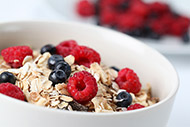
Research shows that frozen foods can be as healthy as their fresh counterparts if you choose wisely. Here are tips for selecting the healthiest frozen foods for your family.
Fruits and Vegetables
Plain frozen fruits and vegetables are often harvested at their peak ripeness and flash frozen, which helps to maintain their nutrients. Unfortunately, sauces and flavorings make some options high in fat, sodium, and sugar. It’s important to follow a few guidelines to ensure you get the healthiest version possible.
- Choose vegetables without cheeses or sauces.
- Beware of seasoned vegetables, which often contain excess sodium.
- Skip vegetables that have added rice or pasta. Add your own during cooking to control the nutrition.
- Choose fruits without added sugar or syrup.
Fish and Seafood
Much like frozen fruits and vegetables, fish and seafood are frozen soon after being caught, preserving their nutrients. If you don’t live near a coast with fresh-caught varieties, frozen varieties can be a healthy option for you and for the environment.
- Avoid fried or breaded fish and seafood.
- Check the labels of seasoned varieties for excess sodium.
- Choose fish and seafood with lower mercury levels, such as salmon, tilapia, trout, sole, catfish, shrimp, and oysters. (More low mercury options.)
- Choose sustainable fish and seafood that have not been overfished and that have not been farmed in a way that is harmful to you or the environment. Check out the Monterey Bay Aquarium Seafood Watch Buyer’s Guide for information on the best choices.
Microwave Meals
When you are short on time, frozen meals can be a healthier alternative to fast food or processed snacks. While there are many healthy options available, it’s important that you check nutrition labels closely to avoid getting excess calories, fat, and sodium. These are a few things nutrition professionals recommend when it comes to selecting healthy frozen meals.
- Choose a meal with 350 to 500 calories so that it feels like you have eaten a full meal and not a snack. Skimping on calories may leave you hungry.
- Select meals with fewer than 600 milligrams of sodium.
- Look for meals with no more than 3.5 grams of total fat per 100 calories, fewer than 2 grams of saturated fat per meal, and no trans fat.
- Choose meals with at least 4 grams of fiber.
- Look for meals with at least 15 grams of protein.
- Choose meals that are balanced with a variety of ingredients that provide fruits, vegetables, whole grains, and lean protein.



 3 Healthy Lunches for Your Work Week
3 Healthy Lunches for Your Work Week
 5 Tips for Stretching Your Budget for Healthy Food
5 Tips for Stretching Your Budget for Healthy Food
 Best Ways to Reduce Added Sugar
Best Ways to Reduce Added Sugar
 Healthy Tips to Lighten Up Picnic Foods
Healthy Tips to Lighten Up Picnic Foods
 Do You Need to Drink Milk?
Do You Need to Drink Milk?
 Tips to Keep Track of Water Intake
Tips to Keep Track of Water Intake
 Butter vs. Margarine: What’s the Best Choice?
Butter vs. Margarine: What’s the Best Choice?
 7 Good Mood Foods
7 Good Mood Foods

 Pinterest
Pinterest RSS Feed
RSS Feed